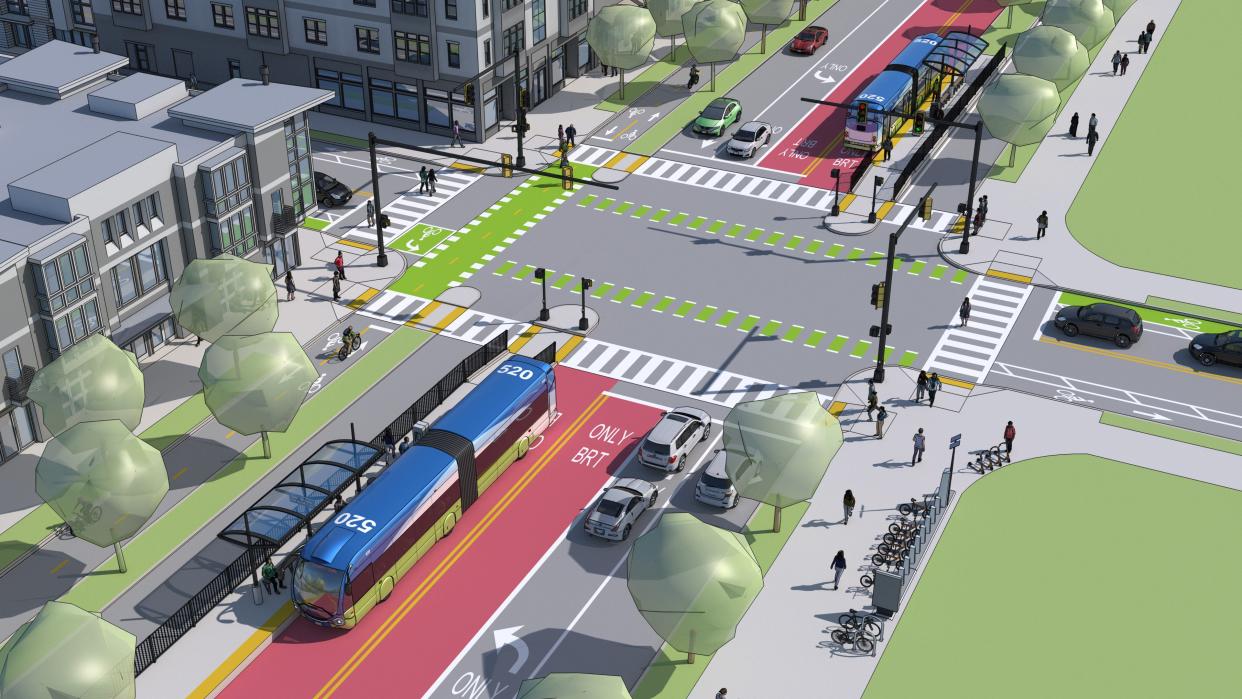It is too hard, dangerous to get around Columbus. Ginther, city council sing LinkUS’ praises.

Caitlin Weiland is a history and pre-law student at Ohio State University.
Connected, convenient, and safe transportation options are a key response to the population swell the Mid-Ohio Regional Planning Commission projects will hit this region by 2050.
This was the message that mobility leaders from Columbus City Council and the Department of Public Service shared with advocates invited to a Mobility and Safety roundtable at City Year on April 9.
We discussed initiatives like Bike Plus, a public engagement-driven plan to create a safe and comfortable network for “micromobility” like bikes and scooters, and Vision Zero, which aims to end traffic fatalities and serious injuries.
LinkUS is the ambitious big picture for the region, proposing to achieve sustainable growth with a highly connected network of sidewalks, quality public transit, protected bike lanes, and trails.

What do you think? How to submit a letter to the editor for The Columbus Dispatch
LinkUS is an $8 billion investment, $6 billion of which would come from a 0.5% sales tax increase that is expected to go to a vote this year.
The community must push LinkUs forward

Columbus Mayor Andrew Ginther’s administration and city council need to sing LinkUS’ praises with every tool at their disposal, because no one can afford for it to fail like plans and designs past.
Central Ohio Transit Authority and other partners decided against putting the increase on the ballot in 2022, worried that backlash from bad economic timing could scuttle transit improvements for a decade.
Columbus leaders must pull out all the stops and build a multi-modal coalition of voter support by November. From a cleaner city to safer streets to preserving commutes that a growing region can tolerate, everyone needs this.
Mobility advocates at the roundtable heard that COTA is expected to ramp up communication soon, and that advocates’ word-of-mouth will be an important tool.
City leaders must also campaign to the 81% of residents who drive alone. They deserve to hear from their elected officials how this initiative will pay dividends. The 2022 walk-back shows that it’s a necessity.
Transportation initiatives have often been a letdown. The $50 million Smart City shuttles are remembered as a flop.
In 2008, Columbus Mayor Michael Coleman launched the Bicentennial Bike Plan, which aimed for 100 miles of bike facilities by 2012.
The plan proclaimed, “Columbus has the potential to be the best bicycling city in the nation.” It yielded more paint and signage than comfort, a far cry from modern designs.
Columbus’s Fall 2021 Bronze rating from the League of American Bicyclists was the same rating it received in 2008, showing it had less than a fourth of the average silver-rated city ridership and spent just 1% of its transportation budget on bicycling, compared to an average of 11% spent by silver-rated cities.
Without implementation behind the talk, Columbus will only ever have potential.
Columbus deserves more than potential
Leaders have ignored known shortcomings at great cost.
A June 2014 Columbus Bike Plan presentation shows people have long wanted protection from cars, and 77% agreed they would bike more if they felt safer.
Later that year, Bill Lewis, the city’s chief mobility engineer, along with Ohio State student intern Stephanie Fibelkorn, were killed by a reckless driver who struck a bus in the intersection of Broad and High streets, crushing them as they walked.
Deaths this year have renewed outrage and demands on the city.
Some city leaders at the roundtable emphasized that they also walk, bike, and bus.
This helps foster trust with advocates, but how will they reach the motoring majority with the required urgency?
A decade passed between the last Bicentennial Bike Plan update and Bike Plus, and between Bill Lewis’s death and this November’s vote to fund more projects that can prevent these senseless tragedies. Another decade of this deadly and dirty status quo won’t work.
Linkus will be well worth it
Car dependency imperils our health and climate goals.
The 2021 Sustainable Columbus Annual Report equated the city’s clean energy aggregation impact to “over 226,000 fewer cars on the road during a year period.”
Yet the Greenhouse Gas Inventory from the same year shows community-scale transportation CO2 emissions of about 4.3 million metric tons—44% of the total.
From 2013-2021, transportation emissions per capita have risen 20% compared to a population growth of just 13%.
LinkUS is a good deal for everyone at just $8.33 per month, and reasons are easy to find. Columbus has the fastest growing urban heat island effect of major U.S. cities.
More engines, parking lots, and wide asphalt streets intensify this. Bike lanes are good for business. They reduce deaths for everyone by calming traffic.

They reduce conflict and congestion and increase ridership, especially when they are high-quality and comfortable for people of all ages and abilities. And for many reasons, people may find themselves unable to drive.
More options represent true independence for all.
Our elected leaders must tailor the message to get this levy passed and build broad support for street projects that define our city’s shared fate.
Our elected leaders must tailor the message to get this levy passed and build broad support for street projects that define our city’s shared fate.
Caitlin Weiland is a history and pre-law student at Ohio State University. She bikes, buses, drives, and walks around her hometown of Columbus where she lived car-free for over a decade.
This article originally appeared on The Columbus Dispatch: LinkUs will make Columbus transportation safer. Leaders must support it.
